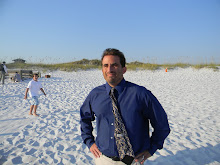When I was a little kid I either wanted to a ballplayer or a rock star. By the time I reached high school, I realized my 5'8" and 165 lbs were not going to be making money from athletics. I had not realized that my lack of singing talent prohibited me from being a rock god so I would write down band names on my notebook; wondering which name people would flock to stadiums to see me rock. Tommy John Elbow always made the top five list of cool sounding band names. I still google the name to make sure no one has snagged it yet. As I create a sports blog today I realized that if someone other than a family member reads this, pandora's box has been opened and some teenage punk with a guitar and a dream can track the name down. So if you hit a Best Buy five years from now and Tommy John Elbow has a CD on the rack, you can say you knew the origin.
Today is not only the birth of this blog but also the birthday of Tommy John. John, who shares his special day with Olympic skater Apollo Anton Ohno, model Naomi Campbell, and iconic Smiths' singer Morissey; was born May 22, 1943 in Terra Haute Indiana. He became a major league baseball pitcher for six teams, starting with the Cleveland Indians in 1963 and ending with the New York Yankees in 1989. In 1974, he was in the midst of one of his finest seasons, crusing to a 13-3 record with the pennant contending Los Angels Dodgers when he permanently damaged his left (pitching) elbow. Had it not been for a revolutionary surigical procedure removing the damaged ulnar collateral ligament and replacing it with a tendon from his forearm, John's promising pitching career would have been over. The enterprising middle-aged surgeon who performed the operation was named Frank Jobe. This was the first successful procedure done on a professional athlete and Jobe named the surgery after his prize patient, Tommy John. John would go on to win 164 more games in 14 more season to finish an impressive resume, 288-231. He missed all of the 1975 season, but his return year, 1976, he went 10-10, shocking the sports world and changing the game of baseball and the games of the other major sports forever.
Dr. Jobe is in his 80s now and retired. He has performed the surgery on thousands of athletes, professional and amateur. Minnesota Twins closer, Joe Nathan, is the latest big name professional athlete to undergo the operation. He is expected back by the 2011 season. The careers of many accomplished athletes including Atlanta Braves pitcher John Smoltz have been saved and expaned as a result.
The dark undercurrent of this amazing medical procedure is little league and high school athletes are having the surgery. Boys as young as 8 years old have been reported having it done. Little League, travel league, and high school coaches are notroiusly overusing their star pitchers, knowing that this "miracle surgery" is an insurance card away. The cost of this operation ranges between $10,000 and $13,000 depending on the severity of the injury. Math was my least favorite subject in school, but if you multiply 10 thousand by 100 thousand, well, you get a bug number. There are no statistics available to determine how many amateur athletes get the procedure and go on to successful professional or even college careers. There is a prevailing myth that those who get the operation, pro and non-pro, are "stronger" or "better" after surgery, and thus that drives the "let's get cut on" mentality.
Sandy Koufax was a star pitcher for the Los Angeles Dodgers in the 1960s. He had a run of success for the first six years of that decade that is mind boggling. He retired at the peak of his career, only 31 years old, with damage to his elbow, shoulder, and joints. Many have speculated that Koufax could have added five to ten years to his career had he undergone the procedures now available to today's players. Koufax played in an era where multi-million contracts did not exist. Tommy John, with his extraa 14 season after surgery, made millions of dollars because he was able to last into the revolutionary free agenct period post 1976. Koufax still made the Hall of Fame, and his greatness is rarely denied, despite his brief career. It is obvious that many players have the operation knowing that more money awaits them upon their return. As do the young amatuer athletes see dollar signs past their surgeries.
All of this poses a cynical but necessary question. How much does Tommy John surgery have to do with medicine and how much does it have to do with medicine?
P.S. I plan on celebrating Tommy John's birthday by going in the backyard, throwing about 327 curveballs until my elbow explodes. I don't have 10 grand, but maybe I can get my wife to cut me open with her sewing needles and replace my hurt ligament with a tendon from my rear end. Having a surgery named after me would be really cool.
Lance
Subscribe to:
Post Comments (Atom)














If Bobina does *that* surgery, be sure to video it and put it on YouTube. It will go viral in less than 30 mins!
ReplyDelete